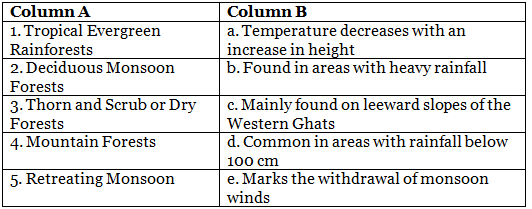Worksheet: India- Climate, Vegetation and Wildlife | Footprints Class 6: Book Solutions, Notes & Worksheets PDF Download
Q1: Multiple Choice Questions (MCQs)
(i) What are the four seasons in India?
(a) Summer, Autumn, Winter, Spring
(b) Summer, Monsoon, Autumn, Winter
(c) Spring, Monsoon, Summer, Winter
(ii) Which factor affects the direction of winds and rainfall in India?
(a) Distance from the sea
(b) Altitude
(c) Latitude
(iii) When does the retreating monsoon season occur in India?
(a) December to February
(b) June to September
(c) October to December
(iv) Where are deciduous monsoon forests mainly found in India?
(a) Western Ghats
(b) Gangetic Plains
(c) Eastern Himalayan foothills
(v) What is the primary purpose of Wildlife Week in India?
(a) Celebrate different species
(b) Raise awareness about conservation
(c) Promote wildlife tourism
Q2: Fill in the Blanks
(i) India has a _______ Monsoon climate in most parts.
(ii) The largest mangrove forests in India are known as ____________.
(iii) Thorn forests are mainly found in eastern and western parts of ___________.
(iv) The Himalayan areas, from Assam to Kashmir, have ___________ type of vegetation.
(v) The first week of October is observed as ____________ in India.
Q3: Match the Column (In a Table)

Q4: True/False
(i) The Great Indian Desert in Rajasthan receives over 200 cm of rain.
(ii) Xerophytic vegetation is mainly found in the Western Ghats.
(iii) The word 'monsoon' is derived from the Arabic word meaning 'wind.'
(iv) The retreating monsoon season is characterized by dry winds blowing from the sea to the land.
(v) The snowline in the Himalayas occurs at 5,000 m and above.
You can access the solutions to this worksheet here.
|
65 videos|127 docs|25 tests
|
FAQs on Worksheet: India- Climate, Vegetation and Wildlife - Footprints Class 6: Book Solutions, Notes & Worksheets
| 1. भारत का जलवायु क्या है और यह किस प्रकार के जलवायु क्षेत्रों में विभाजित है? |  |
| 2. भारत में कौन-कौन से प्रमुख वनस्पति तंत्र पाए जाते हैं? |  |
| 3. भारत की जैव विविधता में कौन-कौन से जीव-जंतु शामिल हैं? |  |
| 4. जलवायु परिवर्तन का भारत के वनस्पति और वन्यजीवों पर क्या प्रभाव पड़ता है? |  |
| 5. भारत में वन्यजीवों के संरक्षण के लिए कौन-कौन से कार्यक्रम चलाए जा रहे हैं? |  |















